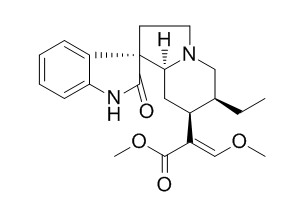Corynoxine B
Corynoxine B, a natural autophagy inducer, restores the deficient cytosolic translocation of HMGB1 and autophagy in cells overexpressing SNCA, which may be attributed to its ability to block SNCA-HMGB1 interaction. Corynoxine B exhibits prolongation of the thiopental-induced hypnosis on oral administration in mice.
Inquire / Order:
manager@chemfaces.com
Technical Inquiries:
service@chemfaces.com
Tel:
+86-27-84237783
Fax:
+86-27-84254680
Address:
1 Building, No. 83, CheCheng Rd., Wuhan Economic and Technological Development Zone, Wuhan, Hubei 430056, PRC
Providing storage is as stated on the product vial and the vial is kept tightly sealed, the product can be stored for up to
24 months(2-8C).
Wherever possible, you should prepare and use solutions on the same day. However, if you need to make up stock solutions in advance, we recommend that you store the solution as aliquots in tightly sealed vials at -20C. Generally, these will be useable for up to two weeks. Before use, and prior to opening the vial we recommend that you allow your product to equilibrate to room temperature for at least 1 hour.
Need more advice on solubility, usage and handling? Please email to: service@chemfaces.com
The packaging of the product may have turned upside down during transportation, resulting in the natural compounds adhering to the neck or cap of the vial. take the vial out of its packaging and gently shake to let the compounds fall to the bottom of the vial. for liquid products, centrifuge at 200-500 RPM to gather the liquid at the bottom of the vial. try to avoid loss or contamination during handling.
Planta Med.2023, 2192-2281
Int J Mol Sci.2021, 22(16):8641.
Biosci Biotechnol Biochem.2021, 85(10):2153-2160.
Int Immunopharmacol.2019, 71:361-371
Microb Biotechnol.2021, 14(5):2009-2024.
LWT-Food Sci Technol2020, 109163
Phytother Res.2015, 29(7):1088-96
Biomedicines.2022, 10(2):463.
J Agric Food Chem.2021, 69(14):4210-4222.
J Nat Med.2021, doi: 10.1007.
Related and Featured Products
Autophagy. 2014 Jan;10(1):144-54.
HMGB1 is involved in autophagy inhibition caused by SNCA/α-synuclein overexpression: a process modulated by the natural autophagy inducer corynoxine B.[Pubmed:
24178442 ]
SNCA/α-synuclein and its rare mutations are considered as the culprit proteins in Parkinson disease (PD). Wild-type (WT) SNCA has been shown to impair macroautophagy in mammalian cells and in transgenic mice.
METHODS AND RESULTS:
In this study, we monitored the dynamic changes in autophagy process and confirmed that overexpression of both WT and SNCA(A53T) inhibits autophagy in PC12 cells in a time-dependent manner. Furthermore, we showed that SNCA binds to both cytosolic and nuclear high mobility group box 1 (HMGB1), impairs the cytosolic translocation of HMGB1, blocks HMGB1-BECN1 binding, and strengthens BECN1-BCL2 binding. Deregulation of these molecular events by SNCA overexpression leads to autophagy inhibition. Overexpression of BECN1 restores autophagy and promotes the clearance of SNCA. siRNA knockdown of Hmgb1 inhibits basal autophagy and abolishes the inhibitory effect of SNCA on autophagy while overexpression of HMGB1 restores autophagy.
CONCLUSIONS:
Corynoxine B, a natural autophagy inducer, restores the deficient cytosolic translocation of HMGB1 and autophagy in cells overexpressing SNCA, which may be attributed to its ability to block SNCA-HMGB1 interaction. Based on these findings, we propose that SNCA-induced impairment of autophagy occurs, in part, through HMGB1, which may provide a potential therapeutic target for PD.
Phytomedicine. 1998 Apr;5(2):83-6.
Effect of oxindole alkaloids from the hooks of Uncaria macrophylla on thiopental-induced hypnosis.[Pubmed:
23195758 ]
METHODS AND RESULTS:
Four tetracyclic oxindole alkaloids, rhynchophylline, isorhynchophylline, corynoxine and Corynoxine B were isolated from the hooks of Uncaria macrophylla Wall. (Rubiaceae), that is a dominant plant widely distributed in Yunnan province.
CONCLUSIONS:
These compounds exhibited prolongation of the thiopental-induced hypnosis on oral administration in mice.
Autophagy. 2017;13(11):1969-1980.
Phosphoproteome-based kinase activity profiling reveals the critical role of MAP2K2 and PLK1 in neuronal autophagy.[Pubmed:
28933595 ]
Recent studies have demonstrated that dysregulation of macroautophagy/autophagy may play a central role in the pathogenesis of neurodegenerative disorders, and the induction of autophagy protects against the toxic insults of aggregate-prone proteins by enhancing their clearance. Thus, autophagy has become a promising therapeutic target against neurodegenerative diseases.
METHODS AND RESULTS:
In this study, quantitative phosphoproteomic profiling together with a computational analysis was performed to delineate the phosphorylation signaling networks regulated by 2 natural neuroprotective autophagy enhancers, corynoxine (Cory) and Corynoxine B (Cory B). To identify key regulators, namely, protein kinases, we developed a novel network-based algorithm of in silico Kinome Activity Profiling (iKAP) to computationally infer potentially important protein kinases from phosphorylation networks. Using this algorithm, we observed that Cory or Cory B potentially regulated several kinases. We predicted and validated that Cory, but not Cory B, downregulated a well-documented autophagy kinase, RPS6KB1/p70S6K (ribosomal protein S6 kinase, polypeptide 1). We also discovered 2 kinases, MAP2K2/MEK2 (mitogen-activated protein kinase kinase 2) and PLK1 (polo-like kinase 1), to be potentially upregulated by Cory, whereas the siRNA-mediated knockdown of Map2k2 and Plk1 significantly inhibited Cory-induced autophagy. Furthermore, Cory promoted the clearance of Alzheimer disease-associated APP (amyloid β [A4] precursor protein) and Parkinson disease-associated SNCA/α-synuclein (synuclein, α) by enhancing autophagy, and these effects were dramatically diminished by the inhibition of the kinase activities of MAP2K2 and PLK1.
CONCLUSIONS:
As a whole, our study not only developed a powerful method for the identification of important regulators from the phosphoproteomic data but also identified the important role of MAP2K2 and PLK1 in neuronal autophagy.



